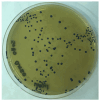Characterization of a Ligilactobacillus salivarius Strain Isolated from a Cheese Seal Which Was Last Used in 1936
- PMID: 38998510
- PMCID: PMC11241558
- DOI: 10.3390/foods13132005
Characterization of a Ligilactobacillus salivarius Strain Isolated from a Cheese Seal Which Was Last Used in 1936
Abstract
Cheesemaking played a pivotal role in the life of the Pyrenean villages where cheese was a most prized commodity and the subject of much local competition. In one of them (Sasa de Sobrepuerto), Mrs. Sebastiana Palacio decided in 1877 to label all the cheeses made in her household with a seal to differentiate them from those made by other local producers. The cheese seal was last used in 1936 and, since then, it has been kept under excellent storage conditions. Since well-preserved cheese seals are rare, and bacterial cells may survive desiccation for long periods, the objective of this work was to isolate and characterize any lactic acid bacteria that survived in the seal. Analysis of the milky crust material revealed the presence of sheep caseins. Culture-based analysis led to the isolation of a strain of Bacillus licheniformis and a strain of Ligilactobacillus salivarius (L. salivarius SP36). The latter was characterized in vitro for safety and dairy-related functional properties. Its genome encodes several genes involved in protein, peptide, and amino acid catabolism, and flavor. Overall, the phenotypic and genetic features of this strain support a high potential for being used as adjunct culture in cheesemaking.
Keywords: Ligilactobacillus salivarius; adjunct culture; cheese; cheese seal; genome mining.
Conflict of interest statement
The authors declare no conflicts of interest.
Figures



References
-
- Krausmann F. Milk, manure and muscular power. Livestock and the industrialization of Agriculture. Hum. Ecol. 2004;32:735–773. doi: 10.1007/s10745-004-6834-y. - DOI
-
- Muchnik J., Biénabe E., Cerdan C. Food identity/food quality: Insights from the “coalho” cheese in the Northeast of Brazil. Anthropol. Food. 2005;4 doi: 10.4000/aof.110. - DOI
Grants and funding
LinkOut - more resources
Full Text Sources

